Chefs share BBQ tips and techniques plus BBQ Bootcamp at Alisal Ranch.
Every region of the United States has three things in common: baseball, apple pie, and BBQ. Texas has beef, the Carolinas have pork, Kansas City has sauce, Memphis has ribs and California has Tri Tip. What’s better than the tender texture and smoky flavor of anything cooked over wood and fire?
Versions of preferred sauce, rub, protein and wood vary greatly and are defended regionally. The technique is lavished on anything from veggies to the most sophisticated protein with brilliant results. As Lucille’s Smokehouse Bar-B-Cue Executive Chef Chris Ferrell points out, “Most traditional BBQ is made with the least expensive ingredients; only time and technique are required to make them delicious.”
One meat not often thought of is bologna. Tim DeCinces, managing partner of Tustin Roadhouse and Beach Pit BBQ comments, “A whole log of bologna in the smoker for 8 hours is just awesome. Smoked Bologna is a Southern delicacy.” His restaurant in Tustin recently added southern dishes and full service at dinner to make it a more desirable evening destination. “The Tustin Garage is such an amazing building. We wanted to do more at night. It will still be casual and all, but people want to be taken care of at the end of their day and usually like the option of a cocktail. The new menu items are going very well. People are raving,” he says. How could they not, with dishes such as Roadhouse 3-Way Double Cut Pork Chop – brined for a day, smoked for a day then hand cut, grilled and topped with Creole maple glaze; Brisket Tips – the tender point of the brisket smoked, seasoned, sauced and smoked again; or St. Louis Spare Ribs, Chicken and Pulled pork? A don’t miss for BBQ cravings.
BBQ’d and grilled seafood are also popular. Executive Chef Vania Almeida serves the little known but amazing BBQ Pacu ribs on her menu at Second Story at the Belamar Hotel in Manhattan Beach. She discovered the South American fish while watching an Argentinean chef now in San Diego prepare them on the Food Network. Intrigued, she contacted her purveyor and ordered some. Available from March to September, Chef Almeida serves them on her summer menu with a citrus-based BBQ sauce.
Quail, venison, rattlesnake, raccoon, possum, ostrich and squirrel have all been grilled somewhere; although they may not be easily accessible, and may not suit every taste. More typical is beef, pork, sausage, lamb, turkey, duck, and chicken. Every chef loves to cook whole animals when feasible, and the flavor imparted by the grill process is unmistakable. “It adds a char that you can only get by grilling and nothing beats it,” says Chef Joseph Gotti,Bri¼ Grill & Market in Lake Forest.
“The high heat involved really locks in the juices,” adds Wildfish Seafood Grill Executive Chef Keith Stich. At his restaurant in Newport Beach, they use mostly charcoal but occasionally add mesquite for its earthy, almost nutty flavor.
“At Three Seventy Common Kitchen+Drink, we grill by cooking over wood, which imparts a natural smoky flavor and allows meat to sear more evenly. The technique is a bit difficult to master, though,” says Chef/Owner Ryan Adams. At his Laguna Beach restaurant they cook over a mesquite and white oak mix, but sometimes add grape vine trimmings, hickory or applewood.
Chef Ferrell of Lucille’s uses hickory for “just right” smokiness, finding other woods either too mild or too heavy.
Parks Barbecue, a popular Korean style BBQ in Koreatown, grills meat on the table in front of guests. When serving galbi, a marinated short rib, “Charcoal gives a special taste and smell,” explains Jenee Kim, manager. The servers use beef suet to keep the meat from sticking and while meat is the focus, Kim believes “Korean food is considered one of the healthiest because of its many combinationsof meat and vegetables.” Their banchan, side dishes served along with rice, includes kimchi, radish, bean sprouts, broccoli, cabbage,pumpkin, cucumber and more.
Cinnamon or pimento wood is favored in Jamaica because it grows there according to Chef Don Schoenburg, who currently cooks for Myetts in Cane Garden Bay, Tortola, BVI. “The flavor is cinnamon. It smells very nice and because they remove bark the flavor is very subtle and not overpowering.” He recently cooked a whole pig for seven hours, describing the results as crispy on the outside and falling off the bones on the inside.
Moving closer to home, the Santa Inez Valley is known for grapes and wine, particularly pinot noir and syrah. The area is a feast for the senses with wide open spaces, trout-filled rivers and lakes, and lushly wooded rolling hills. The location of Alisal Ranch, where we spent four days in BBQ Boot Camp, could not be more ideal for savoring food cooked outdoors. The estate has thrived as a cattle ranch as it has for generations since its inception as a Mexican land grant. Vaqueros, Mexican cowboys, would chow on beef BBQ’d over a red oak fire. Customary sides were pinquito beans and bread, never sauce.
A tradition known as Santa Maria BBQ is the star of the curriculum at Alisal’s BBQ Boot Camp. Tri-tip, the cut of beef from the bottom sirloin, was typically used for ground beef or sliced into steaks until the late 1950s when it became a local specialty. When sliced, the meat has a unique tender texture and flavor. Santa Maria BBQ is now synonymous with tri-tip rubbed with salt, pepper, spices, and cooked whole on a rotisserie or grill.
 We indulged in dazzling days of sunshine for brisk morning horse rides, outdoor grilling lessons, a spice blending seminar and dinners accompanied by local pinot noir and syrah. Everything was made doubly appetizing by the crisp air, wood-fire-meat aromas, outdoor arenas, and fabulous company. A feast of meat yes, but my “best bite” was the blue cheese stuffed brussels sprouts wrapped in Brad’s bacon grilled over medium heat. Yes, it’s good as it sounds. Bradley Lettau has been the chef of Hitching Post for 30 years.
We indulged in dazzling days of sunshine for brisk morning horse rides, outdoor grilling lessons, a spice blending seminar and dinners accompanied by local pinot noir and syrah. Everything was made doubly appetizing by the crisp air, wood-fire-meat aromas, outdoor arenas, and fabulous company. A feast of meat yes, but my “best bite” was the blue cheese stuffed brussels sprouts wrapped in Brad’s bacon grilled over medium heat. Yes, it’s good as it sounds. Bradley Lettau has been the chef of Hitching Post for 30 years.
Executive Chef Pascal Gode and Master Grilling Chef Frank Ostini led entertaining classes filled with helpful hints and hands-on practice. In classes covering basic grills and utensils, many different preferences were explored in illustrating that each BBQ chef is unique. Alisal’s French born Chef Gode used Pam to spray the grill; Ostini, chef/owner of the Hitching Post, made famous by the movie Sideways, rubbed his with a big chunk of beef fat supplied by Gode.
Another difference between the two, who joke and play off each other in a well seasoned routine, is in their approach to seasoning. Gode creates different spice blends and lavishes compound butters that he deems “his little slice of heaven.” Ostini uses “magic dust” salt, pepper and garlic on meat, and the same plus butter, white wine and lemon on seafood.
At the spice blending seminar, a long table with bowls of cumin, oregano, cayenne, onion power, and more was laid. After discussing the flavor profiles, each guest was given their own bowl to sample and blend according to their taste. We were to choose based on whether the blend was for fish, steak or chicken. Each chef was available to sample the blend and make suggestions. We were given a jar and label to take home along with samples from Ostini and Gode.
Using touch to check meat doneness was also explained. Flesh resistance was the factor to weigh for doneness, but thermometers were utilized when questions arose. Less resistance equals less cooked, more resistance is more done. The practice of removing the meat to let it rest was demonstrated as all items continue to cook a while longer off the heat.
Both chefs use the local red oak wood, but Ostini prefers his without bark and Gode with for stronger flavor.
Gode with for stronger flavor.
A highlight was the grill-your-own evening where we could use our blends and newly acquired knowledge to grill our own meat. Newport Meat’s Robert Esser, shared his expertise on meat purchasing and preparation.
Figueroa Mountain Brewing Co introduced us to some proprietary brews at the opening reception, and excellent local wines were generously poured at receptions and dinners. Private label wines from Alisal Ranch, Hartley Ostini Hitching Post, and Melville Vineyards and Winery wines were presented and sampled. While best known for Pinots and Syrahs, Cabernet, Chardonnay and Riesling grapes all thrive in the region’s climate. Our offsite visits included Foley and Babcock vineyards. Gray Hartley hosted a wine reception with Hitching Post II Wines; Winemaker Chad Melville discussed his vintages at our final evening’s reception.
The primal appeal, scent, and taste of food cooked over burning wood according to Chef Adams, “plays with our food memories and is just plan sexy.”













